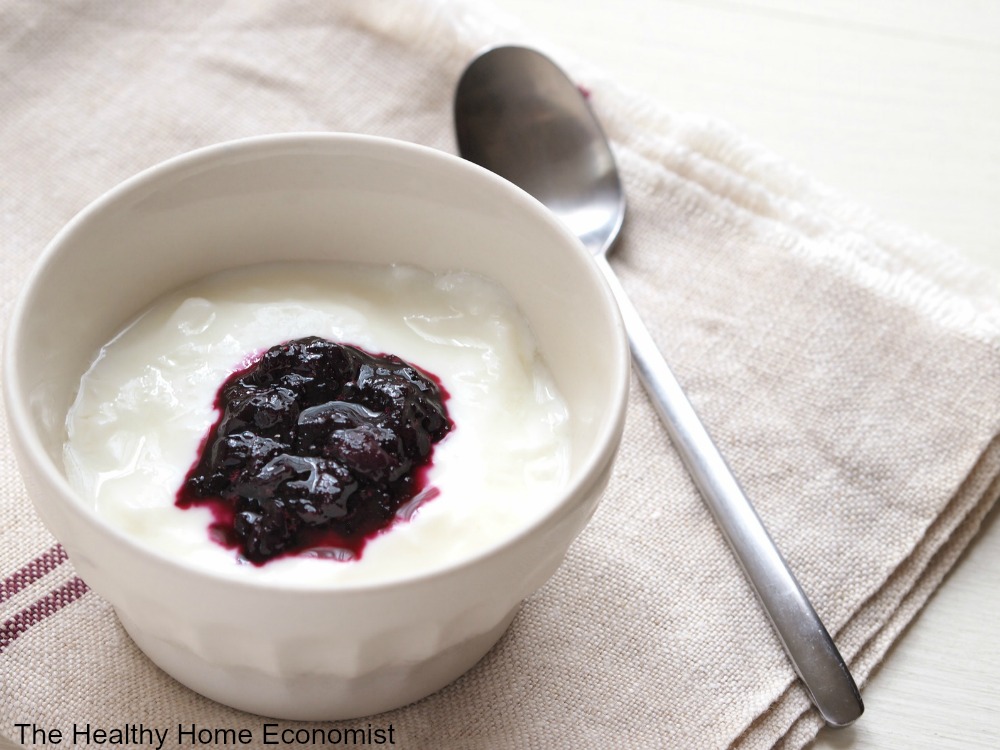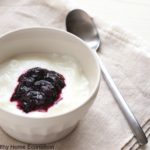 If you’ve watched even one of the videos from the 100+ Real Food video library available on this blog, you probably know that I have a microwave in my kitchen.
If you’ve watched even one of the videos from the 100+ Real Food video library available on this blog, you probably know that I have a microwave in my kitchen.
Do I use it for cooking or heating anything that my family consumes?
No. I haven’t used a microwave to heat or cook anything in many, many years. I much prefer my small countertop convection oven which doesn’t heat food unnaturally and creates carcinogens like a microwave does.
Why don’t I just remove the microwave from my kitchen then? The truth is that the microwave can function as a handy airtight cupboard and proves quite useful for other tasks besides cooking and heating believe it or not.
I mentioned in one of my Real Food videos that I frequently use it for airtight, room temperature storage of freshly baked bread, cookies, and other baked goods.
It also works very well for making homemade raw yogurt. It is, of course, made from unpasteurized milk.
What about Greek yogurt? Is Greek yogurt better? How about the similar German style cheesy yogurt known as Quark? While not necessarily healthier, if you make it yourself allowing sufficient time for probiotic inoculation, these are certainly a nutritious choice! It is ultimately a personal preference as long as the yogurt is fermented properly.
If you don’t have access to raw yogurt, whether regular or Greek, then you don’t know what you’re missing. Pasteurized yogurt even if organic pales in comparison to the digestibility and nutrient value of raw yogurt, so if you are able to snag some raw milk from a local farm, here’s how to make it into raw yogurt.
While the recipe below works fine using the microwave as the incubator, yogurt made in a slow cooker is more dependable in texture.
*This helpful recipe idea was given to me by my friend Cynthia Calisch, who has passed away. May she rest in peace.

Raw Yogurt Recipe
How to make raw yogurt using the microwave as the perfect incubation unit (turned off). When raw, yogurt has a pleasant drinkable style texture compared with scoopable heated yogurt.
Ingredients
- 1/4 cup Plain, whole milk yogurt preferably organic and grass-fed
- 3 3/4 cups Raw cow or goat milk preferably grass-fed
Instructions
-
Scoop 1/4 cup of the plain whole milk yogurt into a clean, wide mouth, glass mason jar (I like these). After you've made raw yogurt one time, you can use your own raw yogurt as the starter for subsequent batches.
-
Warm the raw milk on the stove to between 105 - 117F. No enzymes or nutrition is lost heating to this temperature but the warmed milk enables the yogurt culture to "take" better than room temperature raw milk.
-
Pour about half a cup of the warmed milk into the mason jar and mix with the yogurt.
-
Pour the remaining warmed milk into the mason jar, stir and close the lid tightly.
-
Wrap the mason jar in a thick hand towel, secure with a rubber band and place inside your microwave closing the door. Leave the light in the microwave on to keep a bit of warmth inside.
-
In 24 hours, open the microwave and voila! You will have yourself a lovely quart of raw yogurt!
More Information








I have tried raw milk yogurt several times and I never get it right. If you were using a dyhrator, what temp would you set it and how long to leave it? I tried my light in my microwave and mine will not come on while not on. Strange! But I do have a dyhrator. Also, I don’t have that brand of yogurt in my area, what would be another choice? Any thoughts?
I obviously did not title this post very well 🙁
Poor Sarah…. pat..pat..pat. We love you!
Great idea! I use my microwave as a baked goods cupboard too 🙂
Well I don’t see how a light in a microwave is giving off any more radiation then you get from sitting in front of a computer while reading this article.
If its the light or the microwave that is bothering you there are other ways of keeping it warm. Like in a cooler wrapped up tightly with warm towels fresh from the dryer. Or put it in your oven with its light on and the door propped just ajar.
Sarah, this may sound silly but can you make yogurt from raw cream? I have made raw milk yogurt a couple times before and it seems like the top layer is so creamy and amazingly wonderful, and I thought that it might be thicker from cream rising to the top?!?! I may be way off on that one. I also noticed that raw milk yogurt seems to not spoil, or if it does it takes a lot longer then non-raw homemade yogurt.
Thanks for all your posts! Please never retire from blogging!!!
Another friend uses a cooler .. yes this works too but the microwave with the light on with the door closed works better. Yes, the oven works well too the problem is that we use the oven where the microwave is not used and wasted space unless you get creative 🙂
I think what you would end up with instead of yogurt if you fermented straight cream with a yogurt culture would be something similar in texture and taste to creme fraiche.
You’re so right .. raw milk yogurt never spoils it seems. At least I’ve never wasted a drop at my house.
So I have to admit – this is an attention-grabbing title.
How do you leave the light on in the micro with the door closed?
Mine has a “light” button on the front where you can turn on the light with the door closed.
I was thinking the same thing as Melissa. My microwave doesn’t have a button to turn the light on and off, so it doesn’t work for us! However, thankfully we are able to use our dehydrator for our raw milk yogurt.
It’s an interesting post, thank you Sarah… I often look at my dejected microwave and wonder what I could do with him… 🙂
mine doesn’t have a light either…but I am boiling a pot of water on the stove and am going to put it in a bowl in the microwave for a heat source. This is how I used to do it, but with a cooler. I love this idea of using the microwave….no big clunky cooler on my counter.
you could put the yogurt it in the oven with just the oven light on, this is how I do it and it works perfectly every time. Just be sure to put it in before bed, so a bulk of the fermenting is done while the oven is not needed,
It’s a different kind of heat. It’s like radiation, very unlike the heat from a fire, gas or electric stove. It does more than destroy nutrients, it changes the molecular structure even on low temps.
Oh my . Do people just read the title of the post and comment without even reading it?
All of those things you have mentioned are sources of radiation. Even visible light is radiation.
???? The yogurt is wrapped in a towel. The light would not harm the yogurt even if the towel was not used. I really wish folks would read the post before getting critical.
Hi Sarah … Never mind… I read again and saw it said pastured not pasteurized! 🙂
I was replying to D’s comment, I know Sarah doesn’t use the microwave:)
Sarah, I want to stress that the person using the D for their name here, is not the D. that I usually use when I post. I have communicated with you a time or two by email and I don’t know if email addresses are visible to you when people sign in to post, but I just wanted to be sure to clarify that the other D is not me.
Let me also say that I knew, the minute I read the headline, there had to be a catch because I know you don’t use a microwave. You use a microwave in the same fashion as I use a dishwasher – which is to say, I use my dishwasher to store dirty dishes until I have time to wash them by hand! MY dishwasher (which, btw, is less than a year old) has been serviced four time and still gets the dishes dirtier than when I put them in. The repairmen stand here and scratch their heads but have no clue. Go figure.
No disrespect, but I have a hard time believing that if you’re reheating food in a microwave on a low power level it’s going to destroy significantly more nutrients than conventional heating methods. Here’s a good read if you’re interested: http://perfecthealthdiet.com/?p=1315
The microwave is not being used to reheat anything! Please read the post. It is being used to incubate the yogurt.
Apparently, many are completely not understanding the post at all. The microwave is never even turned on. It is used as an airtight incubator.
Your post is very clear, people just are not bothering to actually read the information
Apologies, thanks for the simple yogurt recipe. However, I’m going to stick to homemade kefir, because it’s less messy :). Concerning the microwave, I was referring to your mention of avoiding microwaves for heating. In my opinion, if you use a microwave at a low power level (allowing food to cook more evenly) and not cook in plastic or other toxic materials, it can be considered a safe and convenient form of heating.
No worries. I just don’t want newbies getting the wrong idea that microwaves are ok to use! The title of this post is an “F” for sure.
YOU didn’t read the comment you replied to! “D” was questioning your condemnation of the microwave, not suggesting that you use it to heat anything when you make yogurt.
Hi Sarah…I noticed that in the ingredients you listed Pasturized raw milk. I thought raw milk was not considered raw if it was pasturized? Was that just a typo?
“Pastured” not “pasteurized”. Pastured means the cows ate grass.
Yeahhhh I was just planning to make some yogurt and I do have Seven Stars! Unfortunately, I do not have access to raw milk, but I do have low-temp pasturization milk.
I also use my microwave to incubate my yoghurt.
Do you strain it and if so do you use cheesecloth?